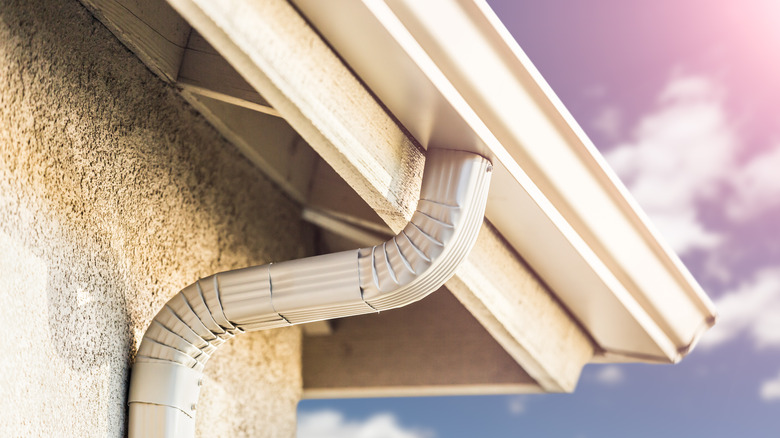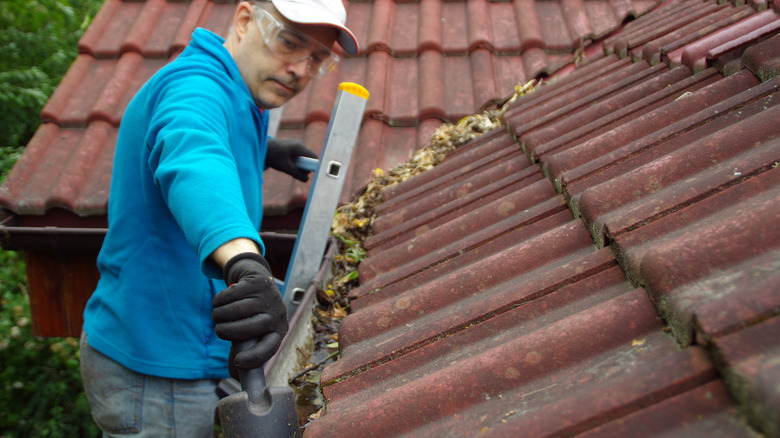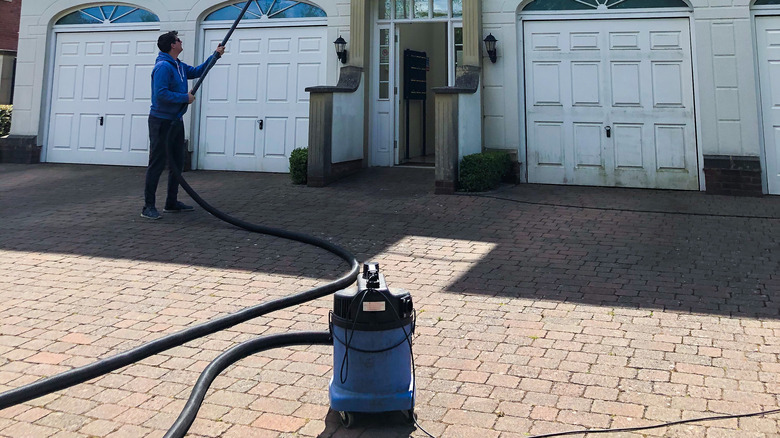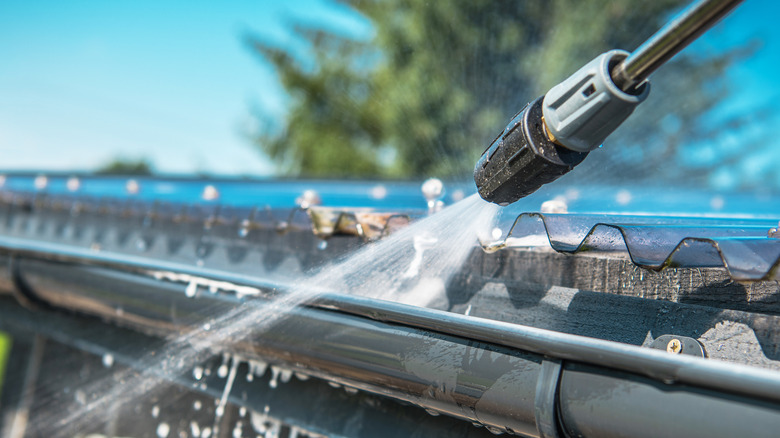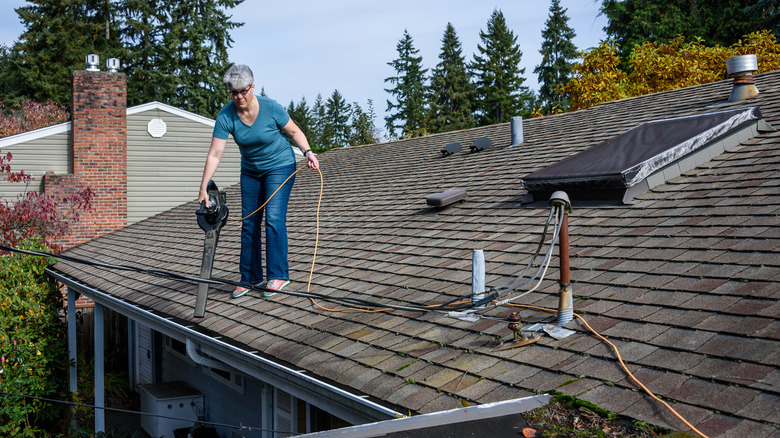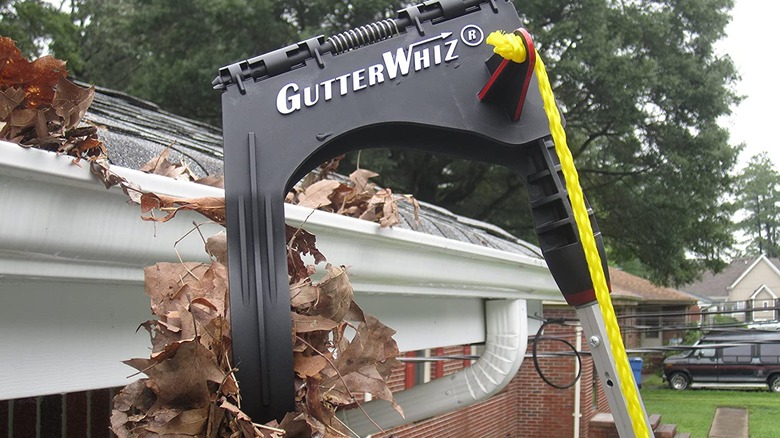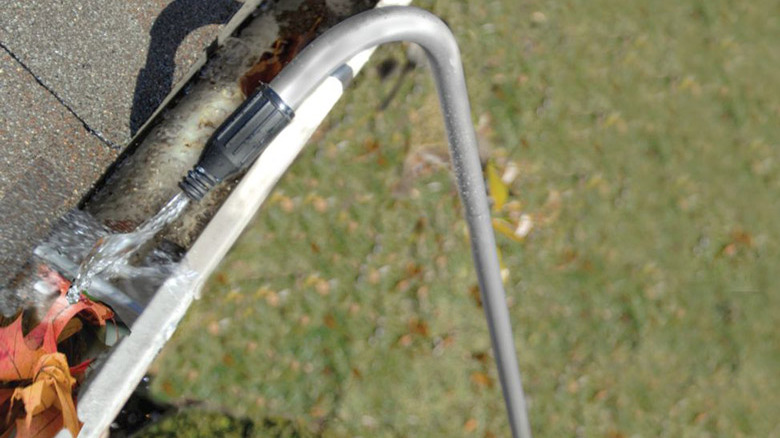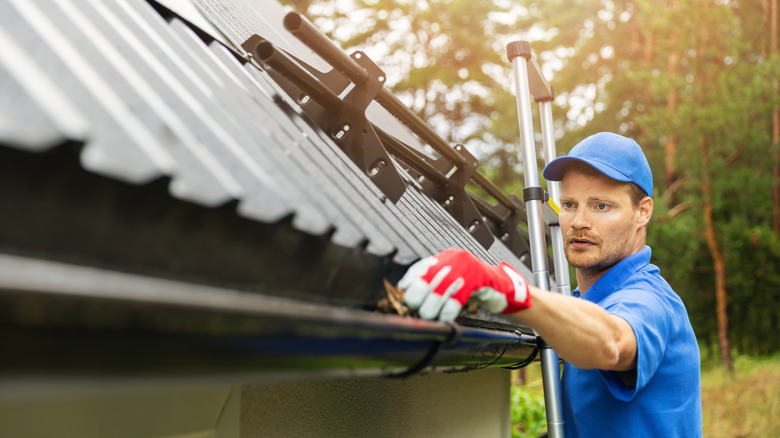How To Really Clean Your Gutters
Granted, gutter cleaning can be a labor-intensive project. However, as Advance Pressure and Gutter explains, inadequate cleaning invites an awful lot of dirt (picture wet clay and foliage, eww) to clog your gutters, which in turn become a mini-farm of unwanted plants, allergenic algae, moss, mildew, and ... blood-sucking mosquitoes.
At this stage, Clean and Clear says critters might find your gutters cozy and make a hotel suite out of your roof; picture destructive raccoons, noisy frogs, nesting birds, and squirrels causing a nuisance in your home. In the end, you wind up with a broken or sagging roof and gutters that leak or splash out runoff water; this in turn floods your basement, destroys your foundation or landscape, causes driveway destruction, invades your rooms, drowns your plants, and causes other bank-breaking, life-threatening damages.
Now, bear in mind that My Gutter Pro says to clean gutters thrice every year — once in spring, autumn, and winter (for a house that's not surrounded by many trees), and five times or more a year (for homes with a large number of trees). Follow the guide below to understand how to really clean your gutters with eight satisfying, effortless, and effective methods.
1. Clear by hand and unclog with plumber's snake
If you're not afraid of heights and do not easily feel grossed out, this conservative method wipes gutters clean and unclogs heavily-blocked downspouts effectively, especially around story buildings, without the need to operate expensive machines. So, what does it take? Well, according to Bob Vila, you need a good ladder, ladder stabilizer with hooks, garden trowel or gutter scoop, plumber's snake, heavy-duty protective gloves, and a bucket or plastic bags. The process is quite easy.
First off, set a ladder against the roof, as explained by This Old House, with your ladder stabilizer also serving as roof protector and the hooks holding the bucket along with other accessories. Now, with protective gloves on, collect settled leaves and foliage from the gutter before finally scraping and scooping out compressed messes into the bucket. Afterward, bust through clogs in the downspouts with the plumber's snake. Finally, pour a bucket of water into the gutter and down the downpipes to expose hidden leaks and permanent blockages (which are to be fixed professionally).
2. Utilize a gutter vacuum
Not everyone is cut out for ninja-climbing ladders or having direct contact with gross messes. Luckily, there are some specially-engineered vacuum systems for roof gutter cleaning available on the market, though you may choose to build your own DIY gutter vacuum. According to Roof Repair Malaysia, gutter vacuums are operated from the ground; they save energy and time, and on top of that, are so powerful they can clear off the most stubborn clogs without you having to mount a ladder or risk a power washer breaking your gutter. Gutter vacuums, such as the SkyVac Mighty Atom that accesses gutters up to four stories high, are ideal for fast, thorough commercial and domestic gutter cleaning, indoor high-level cleaning, clearing of blocked drains, removal of standing water, and execution of cleaning projects that are too tough for your standard indoor vacuum, thanks to their high-suction power.
Operating these systems is a walk in the park, as The Leaflet writes; all you have to do is press a button to adjust the wand extension to the desired height where the sucking nozzle curls over the edge of gutters to suck in both wet and dry debris directly to the vacuum chamber. Careful though — when buying a gutter vacuum, some models/grades do not offer enough suction pressure to lift super-sticky messes. Just so you never go wrong with your choice, we suggest considering the buyer guide and recommendations by Unblock My Gutters.
3. Pressure wash with soapy water
If you have an abundant supply of water and are ready for some fun water-blasting moments, this method may be the most feasible way to free tightly-blocked downpipes and convert gutters from gross to sparkling clean. As explained by Roof Repair Malaysia, all you need is a setup of your pressure washer and a telescopic wand extension. With the hook-like curved wand attached to the pressure washer and extended inside the gutter, you simply walk around pressing the trigger of your pressure washer gun, blasting off stubborn dirt. Once the gutters are taken care of, you may proceed to the clogged pipes (if there are any) to shoot high-pressure blasts of water until the clogs are blasted out.
Now, get this: The success rate depends on how much power your pressure washer packs and the type of extension wand used. For instance, a wand that extends up to 24 inches, like the Bee Pressure super heavy-duty pressure washer wand, offers higher pressure to clean difficult messes and allows you to thoroughly clean gutters of three-story buildings without standing on a stool.
With that said, Ready To DIY suggests starting this process with just water, then switching to warm soapy water, and then finishing with clean water. This way, loose dirt and gunk are blown out in step one, stubborn messes and stains are lifted off in step two, and the final step does the rinsing. Get it? Great.
4. Use a leaf blower
The applications of a leaf blower go beyond replacing tedious raking and revealing hidden dangers that are ruining your garden. Just like the pressure washer method, by attaching a wand extension to your leaf blower, you can shoot jets of air at high pressure to clean your gutters without the need to climb a ladder.
The only limitation to a leaf blower is that it may not be as powerful against mildew, algae, and sticky messes unlike a pressure washer. Plus, it's ineffective against clogs in pipes. So, you better be ready to deal with those stubborn predicaments later; otherwise, use this method only when the only mess in your gutters is dry, light, and non-sticky (for example, leaves and twigs that can be knocked off with ease). Also just as with working with a pressure washer, and as Mr. Handyman cautions, this is a messy method so it's important to wear goggles and helmets throughout the project to protect against falling litter.
5. Clip out debris with rain gutter tongs
We bet you haven't come across those angled tong thingies with extendable wand control with which you can safely clean your rain gutters from the ground, yet. Gutter tongs, though designed primarily for one-story buildings, eliminate the risk of crawling along your roof and prevent the need to collect debris by hand.
Roof Repair Malaysia describes the application process thus: Spread the arms apart, adjust the extensions to reach your gutter, move the tongs (or jaws) from left to right and right to left until enough debris is collected, clip the collected debris between the two tongs, and finally lift out the debris for disposing of. However, be advised that gutter tongs do not pick up gummed messes as effectively as you would want. For this reason, use them only before the rain or prior to a storm when the deposits in your gutter are still dry and moving freely.
6. Combine garden hose with U-shaped wand extension
Yes, this is the same garden hose you use for watering your plants. In case you don't have one just yet, visit your local home improvement store to purchase it along with a U-shaped wand extension attachment. As ABC Home and Commercial Services points out, this combo offers a simple, stress-free method to take care of minor clogs and debris in a short amount of time, though it can be difficult to use against heavy chunks. Now, just as with every other water-splashing method shared so far, things will get messy inevitably. So, what gives? Wear your protective gear: rain jackets, helmets, protective gloves, boots, and goggles.
Once your U-shaped extension wand is connected to the garden hose, P.J. Fitz Patrick writes, hold and extend it right over the gutter as you position yourself a few steps away from falling debris. After, turn on the hose and adjust until you observe adequate pressure in the gushing water. Finally, shoot water from one end of the gutter to the next until you're done. For a more professional-looking job, wash the exterior of your gutter the same way.
7. Prevent gutter clogging
Imagine not having to deal with this chore in the first place. Yes, you can make that happen by putting the right preventive measures in place to keep your gutters clean. And you've got options; according to Bob Vila, you may choose to install a micro-mesh gutter guard such as the Superior Stainless Steel Screen Technology Gutter Cover that keeps out falling leaves. Or, alternatively, get a professional technician to install the more sophisticated gutter guard system like the Leaf Guard that doubles as a protection against insects, leakages, pollen, and water damage.
A more natural way out of frequent gutter cleaning is to keep a fewer number of trees that shed around your home. As listed by Tips Bulletin, some of the trees that make the most mess of your yard through excessive shedding are oak, sycamore, Bradford pear, mimosa, eastern cottonwood, silver maple, weeping willow, ash, pecan, and sweet gum. Finally, DIY Doctor suggests the installation of other preventive attachments such as foam gutter filters and gutter hedgehog or a gutter brush.
8. Hire professional cleaners
This is the part where we tell you to consider letting the professionals do the work for you, but for a lot of reasons. First off, if you're leading a super busy lifestyle, squeezing in the time and energy to clean gutters yourself can be next to impossible. Also, as pointed by Mr. Handyman, it's reasonable to get professional help when you don't have the physical capabilities to execute the project. Likewise, for those who are allergic to mildew, dust, and algae, cleaning gutters may not be the type of house chore you want to add to your to-do list.
Anyway, once you've decided to go for a gutter cleaning company, Leaf Filter writes to follow six steps guide for choosing the perfect one. The first step is to look for a gutter cleaning business with a brick-and-mortar office that's been up and running for two years or more. After that, contact them to question their operation process, their methods of cleaning, how long they've taken to execute similar jobs in the past, plus their experience and knowledge in the industry. Follow this up by asking for proof of insurance before requesting a warranty (obviously, it's a red flag if they can't guarantee their services). If everything looks good so far, go online to do your research about them; look for their credentials. The final step is to select a company with good customer reviews and customer servoce.

